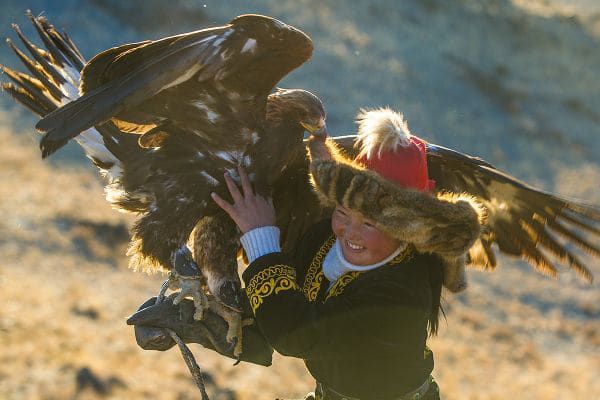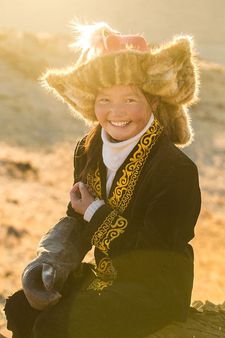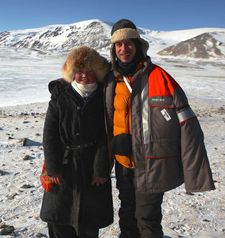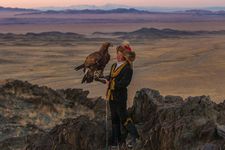 |
| Otto Bell: 'The talons have go 900psi of pressure per square inch, they're the size of a kiddie's fingers. They're killing machines. But you just forget about it' |
 |
| Otto Bell: 'She was a young woman who was really determined and worked hard to achieve what she believed in. To see kids cheering for that is a good feeling.' |
The film opened to a warm reception at Sundance back in January and has since been making its way around the festival circuit and will be released in the UK this Friday (December 15). Since the film debuted in Park City, a touch of stardust has been added courtesy of Star Wars' Daisy Ridley, who provides voice over.
"The version now has about five minutes of narration from Daisy Ridley, although it's essentially unchanged," says Bell. "She called me the night before Sundance. She had seen the film - I think her agent had sent it to her, not with an agenda but just because she thought she would like it.
"That was the night before so we couldn't slot her in, so I was just using cards in that version. But her voice over has really lifted things. It's only about five minutes in the 87 minutes but it makes it easier for kids to track along with it because there are a lot of subtitles and she just turns up at key moments. It just helps orientate things. I think it's brought the age of entry down from around 13 to 10 or 11."
The film is quite inspirational for pre-teens. Was that in your mind when you were shooting it - that you wanted to make it accessible to younger audiences?
It was, honestly. There's a bit of a zeitgeist about these epic female protagonists in far-away lands, striving for victory. Like Katniss Everdeen in [film]Hunger Games[/fiml], Khaleesi "The Mother of Dragons" in Game Of Thrones or Rey in Star Wars, Daisy's character. I thought, 'We've got the real thing here.' So it was in my mind.
So you would have to keep in that mind during the editing, in order to keep kids hooked into it?
I think kids get a bit of a bad rap at the moment - that they can't watch anything for more than 90 seconds on YouTube. It's a lot of stuff and nonsense. The screenings that we're doing for the Girl Guides or what have you, they're transfixed, they sit through the whole hour-and-a-half. Especially when Aisholpan is there. They queue up to take selfies with her and ask the most intelligent questions.
 |
| Otto Bell with Aisholpan: ''ll love nature so long as it unlocks those sort of human connections for everybody' |
It's not about who she's dating or what she's wearing. She was a young woman who was really determined and worked hard to achieve what she believed in. To see kids cheering for that is a good feeling.
How difficult was it for you to shoot the film. I assume it was quite arduous.
It was the hardest thing I've ever done. We filmed in -50C weather. I made the film with three people and my life savings, which wasn't very much money. I went in debt with the bank and I'd never been in debt, so it was quite scary.
It was hard. Everything would break, we had a poor diet, there was no running water, no electricity. It was tough. The final act when she heads out into the tundra to hunt - we put aside five days for that and in the end it took us 22 days.
How hard was it with only having a limited crew? When you're trying to capture a fox dashing about, wild animals aren't going to do things to order for you. Did you just get better at it as you went?
We did a number of things. At key moments, for example when she steals the eagle from the cliff side or at the festival, you only have one go at those, you have to do it in one take. So, in those cases I would just throw cameras at it, so everyone who could hold a camera, would hold a camera. I sprayed it from all different angles to get the coverage. My main DP, Simon Niblett, a fantastic natural world photographer with decades of experience. He'd be filming the eagle in flight - they move at about 150 miles an hour - and he'd be filming them from 300 or 400 yards away. At that distance, your depth of field is down to about a foot or a foot-and-a-half. You've seen the footage, he holds the footage for 30 seconds. A long time. He's incredibly talented.
That said, the thing that did save us was Agalai the father. His understanding of the landscape and the nature out there is kind of preternatural. He can read the environment so well. Through points and gesticulation he would show us where to set up our cameras. Without his understanding of how the truly wild life worked out there, we'd still be trying to film things.
How did the eagle take being harnessed up with a camera?
At first, I was worried that there would be freaked out by the drone, for example, but they weren't, they were fearless. It's funny how fearless you get as well - or more matter-of-fact about it. I had this harness that I'd got from a dog - you know when they send dogs into disaster zones and they have to carry a camera on their back. I adjusted one of those to fit comfortably on the eagle, so I could fly with the eagle, which was something I really wanted to do.
And when you're popping this on, you forget that this thing is the largest species of golden eagle in the world, with a seven or eight foot wingspan. The talons have got 900 of pressure per square inch, they're the size of a kiddie's fingers. They're killing machines. But you just forget about it. When you're trying to get a shot, you never want to slow them down.
In terms of what Aisholpan's doing now, is she just continuing with her life as she was? Because presumably this has made her something of a media star.
 |
| Otto Bell: 'I'm happy to say, Aisholpan will be able to study medicine anywhere she wants in the world' |
How do the community view her now - obviously she was already a bit of a minor celebrity.
She won the competition on merit and they had to give her the award but they were sort of taking away with the other hand, saying, 'Well, you know her dad's a really good trainer and the bird's exceptional', ignoring the fact that she'd broken the record. 'She'll never be able to hack it in winter,' that was the fresh gauntlet they threw down. But I'm happy to say that after the winter, she'd been out hunting with her dad and he'd brought friends along and word spread through the community that she was the genuine article. So there's been a lot of exceptance.
The community asked her to lead the annual New Year parade. I didn't want to finish with that though, I wanted to finish with her and her dad and the personal victory. It's great that the community have accepted her but that's a public validation and she doesn't need that, it's better that she wins it on her own terms, I think. At this year's festival there were another three girls - eagle huntresses, which is cool.
This film is quite unusual in that it's a blend of wildlife documentary and a very humanistic portrait, in terms of going for, do you feel drawn to both of these or one more than the other?
I just like a good story no matter how it comes along. I do understand that this is an exotic film in a number of ways but the alien nature and this otherworldly landscape and those elements are just a sort of a foreign wrapping for what I think is a universal bunch of themes. Ultimately, it's the story of a dad and a daughter and we can all understand it and access it. I'll love nature so long as it unlocks those sort of human connections for everybody. I'm working on the animated version with Chris Wedge, who made Ice Age and Robots. It turns out he saw the same photograph as me - crazy, right? - and he started devloping an animated version. So I've been trying to help him as much as I can.
The Eagle Huntress is currently on release in the US and opens in UK cinemas on Friday, December 16.





















